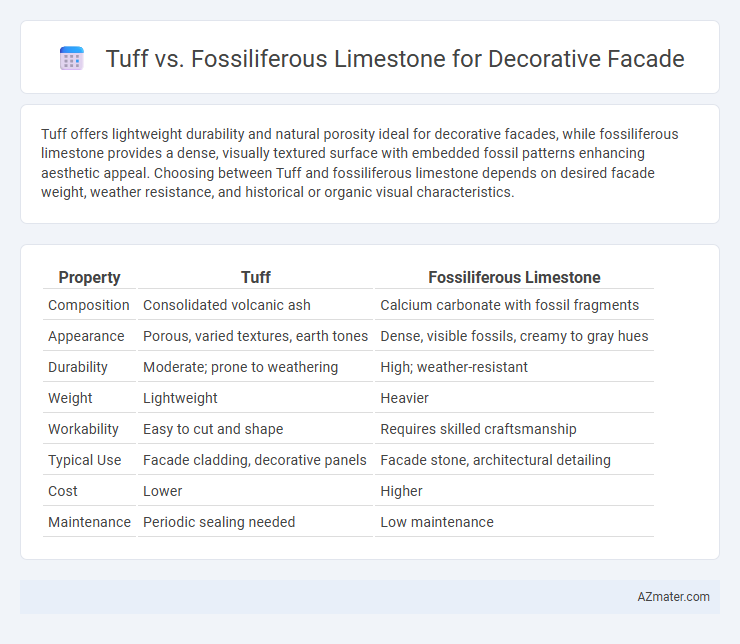Tuff offers lightweight durability and natural porosity ideal for decorative facades, while fossiliferous limestone provides a dense, visually textured surface with embedded fossil patterns enhancing aesthetic appeal. Choosing between Tuff and fossiliferous limestone depends on desired facade weight, weather resistance, and historical or organic visual characteristics.
Table of Comparison
| Property | Tuff | Fossiliferous Limestone |
|---|---|---|
| Composition | Consolidated volcanic ash | Calcium carbonate with fossil fragments |
| Appearance | Porous, varied textures, earth tones | Dense, visible fossils, creamy to gray hues |
| Durability | Moderate; prone to weathering | High; weather-resistant |
| Weight | Lightweight | Heavier |
| Workability | Easy to cut and shape | Requires skilled craftsmanship |
| Typical Use | Facade cladding, decorative panels | Facade stone, architectural detailing |
| Cost | Lower | Higher |
| Maintenance | Periodic sealing needed | Low maintenance |
Introduction: Choosing the Right Stone for Decorative Facades
Tuff and fossiliferous limestone offer distinct aesthetic and structural qualities for decorative facades, with tuff known for its lightweight porosity and warm, earthy tones, while fossiliferous limestone provides intricate fossil patterns and a more durable surface. Selecting the right stone depends on factors such as climate resilience, desired texture, and maintenance requirements, where tuff excels in softer architectural details and fossiliferous limestone suits robust, long-lasting facades. Understanding the geological composition and visual impact of each stone helps architects and designers enhance building exteriors with both functionality and natural beauty.
Geological Origins: Tuff vs Fossiliferous Limestone
Tuff is a volcanic rock formed from consolidated volcanic ash ejected during explosive volcanic eruptions, characterized by its porous texture and lightweight nature. Fossiliferous limestone originates from marine sedimentation, primarily composed of calcium carbonate and abundant fossil fragments like shells, corals, and marine organisms. These distinct geological origins influence their durability, texture, and aesthetic appeal in decorative facade applications.
Visual Appearance and Texture Comparison
Tuff offers a porous, rough texture with natural volcanic patterns that create an earthy, rustic appearance ideal for rustic or Mediterranean-style facades. Fossiliferous limestone features smoother surfaces embedded with visible fossil imprints, adding a unique historical and organic visual element suited for classic or traditional architectural designs. The choice between tuff and fossiliferous limestone depends on desired tactile depth and fossil detail prominence for enhancing decorative facade aesthetics.
Color Variations and Customization Options
Tuff offers a natural range of earth tones including warm browns, reds, and grays, with limited color customization due to its volcanic origin. Fossiliferous limestone provides unique beige to cream shades with visible fossil inclusions, allowing for specialized treatments to enhance or modify its lighter color palette. Both materials support surface finishes like polishing or honing, but fossiliferous limestone allows greater flexibility in enhancing texture and fossil visibility for decorative facade applications.
Strength and Durability in Exterior Applications
Tuff offers moderate strength and durability suitable for decorative facades but is more porous and less resistant to weathering compared to fossiliferous limestone. Fossiliferous limestone exhibits higher compressive strength and better resistance to erosion, making it more durable in exterior applications exposed to harsh environmental conditions. Selecting fossiliferous limestone ensures long-lasting structural integrity and aesthetic appeal in outdoor facades.
Weather Resistance and Maintenance Requirements
Tuff offers superior weather resistance compared to fossiliferous limestone due to its volcanic origin, which provides enhanced durability against moisture and temperature fluctuations. Fossiliferous limestone, while aesthetically rich with embedded fossils, tends to be more porous and susceptible to weathering and acid rain, resulting in higher maintenance needs. Regular sealing and cleaning are essential for fossiliferous limestone facades, whereas tuff requires less frequent upkeep, making it a practical choice for long-term exterior applications.
Workability and Installation Techniques
Tuff offers superior workability for decorative facades due to its softer, more porous nature, allowing easier cutting and shaping with standard masonry tools. Fossiliferous limestone, being denser and harder, requires specialized cutting equipment and careful handling during installation to prevent surface damage to fossil inclusions. Installation techniques for tuff typically involve lightweight anchoring systems, while fossiliferous limestone demands heavier supports and precision alignment to maintain structural integrity and aesthetic detail.
Cost and Availability of Tuff and Fossiliferous Limestone
Tuff is generally more cost-effective than fossiliferous limestone due to its abundant availability and ease of quarrying in volcanic regions, resulting in lower extraction and transportation expenses. Fossiliferous limestone, containing preserved marine fossils, often commands a higher price because of its geological rarity and aesthetic appeal, but its availability is limited to specific sedimentary basins, which can increase procurement costs. When selecting materials for decorative facades, cost efficiency and geographic accessibility make tuff a more practical choice compared to the premium pricing and limited distribution of fossiliferous limestone.
Environmental Impact and Sustainability
Tuff offers a lower environmental impact compared to fossiliferous limestone due to its volcanic origin, which requires less intensive quarrying and processing, reducing carbon emissions. Fossiliferous limestone extraction often disrupts sedimentary ecosystems and generates more dust and waste, negatively affecting local biodiversity and soil quality. Tuff's natural porosity enhances insulation properties, contributing to energy efficiency in buildings and promoting sustainability in decorative facade applications.
Summary: Which Stone is Best for Your Decorative Facade?
Tuff offers lightweight durability and natural porosity, making it ideal for decorative facades in seismic zones and humid climates, while fossiliferous limestone provides a denser, more polished aesthetic with excellent weather resistance and intricate fossil patterns enhancing visual appeal. Fossiliferous limestone may require more maintenance due to its susceptibility to acid rain and pollution, whereas tuff's porous nature demands sealing to prevent water infiltration but excels in insulation properties. The best choice depends on desired aesthetics, environmental conditions, and maintenance capacity, with tuff preferred for rustic, textured facades and fossiliferous limestone favored for refined, historic or classical designs.

Infographic: Tuff vs Fossiliferous Limestone for Decorative Facade
 azmater.com
azmater.com